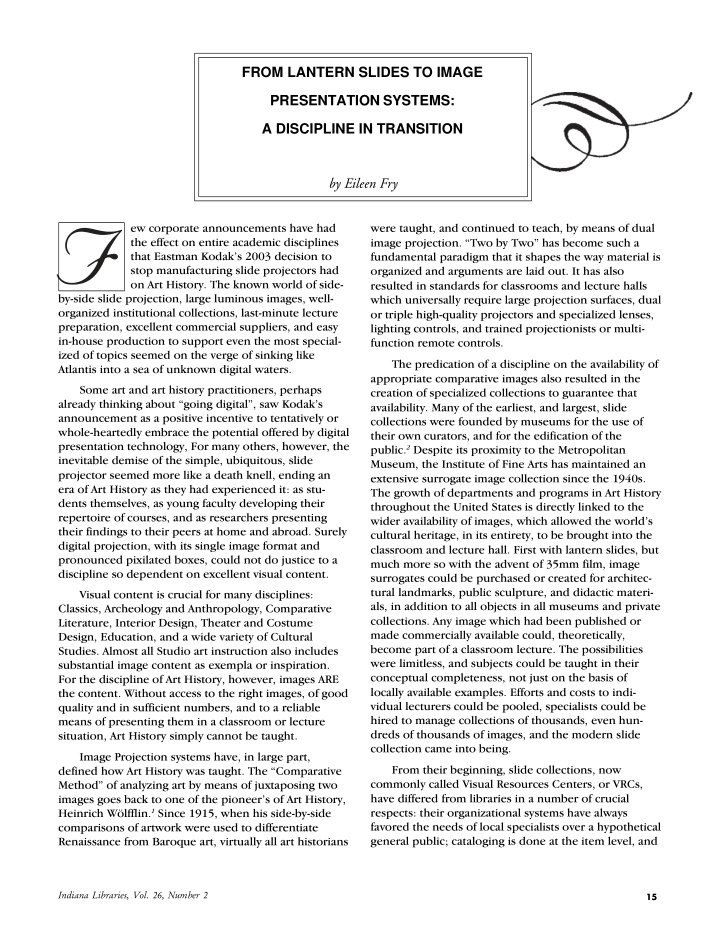



FROM LANTERN SLIDES TO IMAGE PRESENTATION SYSTEMS: A DISCIPLINE IN TRANSITION by Eileen Fry ew corporate announcements have had were taught, and continued to teach, by means of dual the effect on entire academic disciplines image projection. “Two by Two” has become such a that Eastman Kodak’s 2003 decision to fundamental paradigm that it shapes the way material is stop manufacturing slide projectors had organized and arguments are laid out. It has also on Art History. The known world of side- resulted in standards for classrooms and lecture halls by-side slide projection, large luminous images, well- which universally require large projection surfaces, dual organized institutional collections, last-minute lecture or triple high-quality projectors and specialized lenses, preparation, excellent commercial suppliers, and easy lighting controls, and trained projectionists or multi- in-house production to support even the most special- function remote controls. ized of topics seemed on the verge of sinking like The predication of a discipline on the availability of Atlantis into a sea of unknown digital waters. appropriate comparative images also resulted in the Some art and art history practitioners, perhaps creation of specialized collections to guarantee that already thinking about “going digital”, saw Kodak’s availability. Many of the earliest, and largest, slide announcement as a positive incentive to tentatively or collections were founded by museums for the use of whole-heartedly embrace the potential offered by digital their own curators, and for the edification of the presentation technology, For many others, however, the public. 2 Despite its proximity to the Metropolitan inevitable demise of the simple, ubiquitous, slide Museum, the Institute of Fine Arts has maintained an projector seemed more like a death knell, ending an extensive surrogate image collection since the 1940s. era of Art History as they had experienced it: as stu- The growth of departments and programs in Art History dents themselves, as young faculty developing their throughout the United States is directly linked to the repertoire of courses, and as researchers presenting wider availability of images, which allowed the world’s their findings to their peers at home and abroad. Surely cultural heritage, in its entirety, to be brought into the digital projection, with its single image format and classroom and lecture hall. First with lantern slides, but pronounced pixilated boxes, could not do justice to a much more so with the advent of 35mm film, image discipline so dependent on excellent visual content. surrogates could be purchased or created for architec- tural landmarks, public sculpture, and didactic materi- Visual content is crucial for many disciplines: als, in addition to all objects in all museums and private Classics, Archeology and Anthropology, Comparative collections. Any image which had been published or Literature, Interior Design, Theater and Costume made commercially available could, theoretically, Design, Education, and a wide variety of Cultural become part of a classroom lecture. The possibilities Studies. Almost all Studio art instruction also includes were limitless, and subjects could be taught in their substantial image content as exempla or inspiration. conceptual completeness, not just on the basis of For the discipline of Art History, however, images ARE locally available examples. Efforts and costs to indi- the content. Without access to the right images, of good vidual lecturers could be pooled, specialists could be quality and in sufficient numbers, and to a reliable hired to manage collections of thousands, even hun- means of presenting them in a classroom or lecture dreds of thousands of images, and the modern slide situation, Art History simply cannot be taught. collection came into being. Image Projection systems have, in large part, From their beginning, slide collections, now defined how Art History was taught. The “Comparative commonly called Visual Resources Centers, or VRCs, Method” of analyzing art by means of juxtaposing two have differed from libraries in a number of crucial images goes back to one of the pioneer’s of Art History, respects: their organizational systems have always Heinrich Wölfflin. 1 Since 1915, when his side-by-side favored the needs of local specialists over a hypothetical comparisons of artwork were used to differentiate general public; cataloging is done at the item level, and Renaissance from Baroque art, virtually all art historians Indiana Libraries, Vol. 26, Number 2 15
Recommend
More recommend